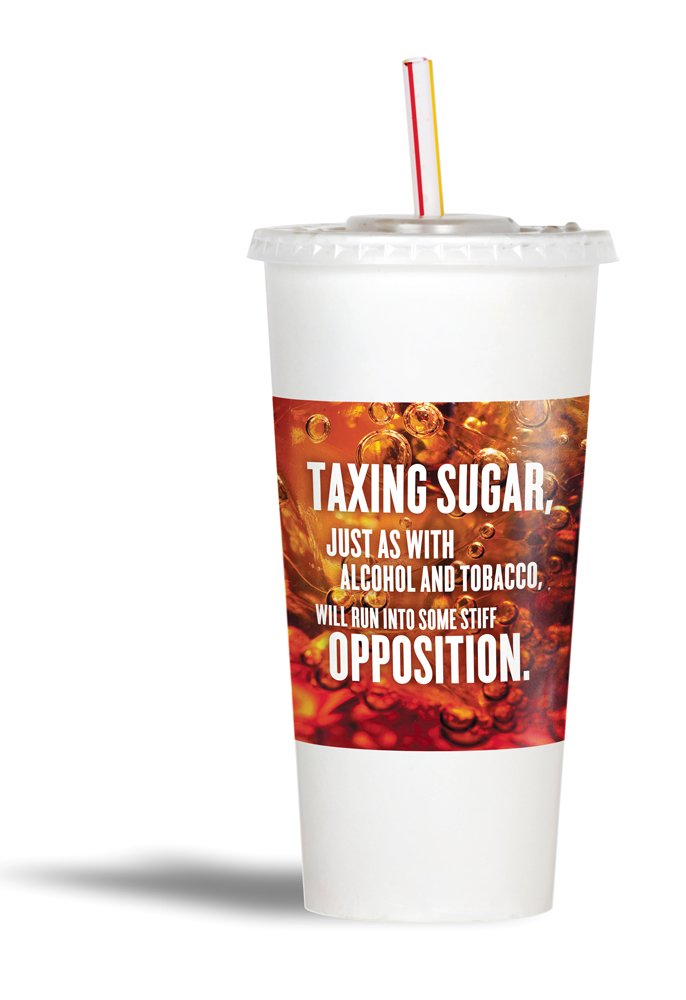
vie-magazine-big-gulp
The Big Gulp
By Clark Peters
Our old friend sugar has been much in the news lately. Driven by growing concern about the nation’s obesity epidemic, focus has finally shifted to the problems of the American diet and lifestyle. While it is probably unfair to single out one factor in the (literally) growing problem, the amount of sugar consumed per capita has closely paralleled the nation’s weight gain. The topic of sugar has been elaborated on in many of my prior articles (“Hydration,” Summer 2009; “Obesity,” Summer 2010; “You Are What You Eat,” Fall 2010), so readers will recall that sugar in all its forms (some, like high fructose corn syrup, are worse than others) is the simplest of all carbohydrates and has the highest glycemic index score. In short, it is a nutritionless calorie source with no nutrients, fiber, vitamins, minerals, or other benefits contained in whole foods. Now, a little sugar is not of itself a toxin and it adds greatly to the flavor of foods and liquids. But, when overconsumed, it leads to insulin spikes (diabetes if continuous), obesity (after current energy needs are met, the excess is stored in fat cells), and a host of other side effects, none of which are good. High blood pressure, mood swings, sleep disruption, and sugar highs and lows are included in a far from comprehensive list of the end results of overindulging in sugar. (Google “sugar toxicity” for more information on this topic.)
So, as with most things related to food, moderation is key. But it has become clear that most Americans are not moderate consumers of sugar—or, indeed, food in general. Our grandparents consumed ten pounds of sugar per capita per year. Now Americans consume one hundred fifty pounds per year!
The concern with our growing size/obesity tends to focus on type 2 diabetes, a lifestyle disease closely correlated with obesity. Currently, some thirty million Americans are diabetic. But projections suggest that by the year 2020 or thereabouts, if nothing changes, the number of diabetics will triple! Indeed, if a condition called prediabetes (also known as Syndrome X) is added to these figures, one out of every two Americans will be included in these categories. Medical costs to treat diabetes alone will exceed $500 billion by 2020.
One person, Mayor Michael Bloomberg of New York City, has recently taken a stab at addressing this problem for his constituents. Citing the well-known fact that portion control is part of the problem (remember Mom’s admonition to always finish what you are served?), he set out to limit the size of sugary drinks to sixteen ounces in the city’s food-service establishments. This may sound like a small step, but sodas are now routinely offered in quantities up to thirty-two ounces; a drink this size is called, appropriately enough, the “big gulp.” Recall that a twelve-ounce can of Coke, Pepsi, Mountain Dew, or any other soda brand contains the equivalent of ten teaspoons of sugar. So, I would argue the mayor’s limit was set too high, even at sixteen ounces. If one ordered the largest size now available in NYC—a “big gulp”—that is the equivalent of a quarter of a gallon! I don’t know who could possibly want that much, but the point is that an enormous quantity of sugar is represented in these large containers. So, small steps—at least Mayor Bloomberg was starting to talk about moderation. The New York City Board of Health fully supported his plan.
The public reaction, however, has been loud and angry. Complaints about the “nanny state” and loss of basic rights have cropped up from a variety of sources. Not surprisingly, many Americans who value our freedoms—one of which is the freedom to make bad choices—do not appreciate being told what they can or can not put in their mouths. I suspect that many of these same people are among those who complain about our nations’ health-care costs. (Note that the restriction on the size of the containers sold does not prevent you from buying additional servings if you desire.)
Clearly, Mayor Bloomberg’s actions were well intentioned and just as clearly, a tiny step in addressing a very large (excuse the pun) problem. Personally, I believe a more effective approach would include some pretty basic economics. Since continued overconsumption of sugar (in all forms—not just soft drinks) will significantly drive health-care costs, why not tax the source problem. This might result in the following:
* An increase in the cost of consumption, which in turn would drive down demand: simple supply/demand curve economics
* Revenues generated to help defray the attendant health costs of sugar’s harmful effects (if consumption remained high despite taxes)
This is far from a blinding new insight. Indeed, this proposal was suggested two hundred years ago by one of our early statesmen, Adam Smith. His prescription went like this: “Sugar, rum and tobacco are commodities which are nowhere necessities of life, [but] which are … objects of almost universal consumption and which are therefore extremely proper subjects of taxation.” In the two centuries since, policy makers have followed his advice—with one glaring exception: sugar. George Washington imposed and then enforced a whiskey tax (1791). Taxes on tobacco followed. Indeed, some years later, policy makers made an ill-advised attempt to ban alcohol (a.k.a. Prohibition). It has been said that it is impossible to legislate morality. But, you can tax it! And the taxes on alcohol and tobacco raise, to this day, prodigious amounts of money for the public coffers. Some of these funds have been used in the public arena on, in addition to health care, ads and education to illuminate the dangers and damage of both substances. Aren’t we well past the time to use the same tactics on sugar—a substance that not only has no redeeming value other than taste but also provides damage and danger to the public? As it stands, this is easier said than done. Taxing sugar, just as with alcohol and tobacco, will run into some stiff opposition.
A recent study showed that overweight kids are drinking 1000 to 2000 calories per day in sodas alone!
In the recent past, when a sugar tax was proposed as part of the health care reform bill, the food and beverage industries unleashed a $57.6 million campaign and blocked it. Even more recently, two years after Washington State imposed a two-cent tax on soft drinks, the industry spent $16 million on the referendum that repealed it. Perhaps more telling was the response in July of this year to Mayor Bloomberg’s portion proposal. Quoting from one respondent among many from all over the country: “… for me, it’s about how I feel at the end of the meal. Yes, I am overweight. [!!] Yes, I know portion control works. I realize there is a movement to justify anti-obesity legislation for the public good. But to relinquish my freedom to act as a free man, even in this case, would put us on a slippery slope.”
Wow! I wonder how free he will feel if he becomes bedridden with heart disease or diabetes. With attitudes like this one (by no means the only one of this nature) and legislators more interested in getting reelected (clearly some of the monies mentioned above lined their pockets) than legislating for the public interest, the prospect of addressing the nation’s sugar addiction seems very slim. Speaking personally, the tax proposal seems like a win-win. The government would generate some desperately needed revenues (given the current dire status of financial affairs in Washington, D.C.) and the nation would get slightly healthier as a result of consuming fewer sugary soft drinks. Yes, the industry would take a hit, but given the profitability of soft drinks (obscenely high), surely they could survive and prosper—just not quite as much. And the consumer would still be left with freedom of choice, albeit at a slightly increased price. Speaking of prospering, the latest sugar news has several fast food chains promoting ninety-nine-cent soft drinks with breakfast!
We are clearly a nation of indulgence befitting our high standard of living. Just as clearly, this indulgence is starting to take its toll on our health. Overall calorie intake has risen since 1970 by about 425 calories per capita per year. Importantly, 16–17 percent of daily calories now come from sugars. Bad enough, but it may be worse for our children (grandchildren, in my age group) who are major targets for the industry’s marketing campaigns. A recent study showed that overweight kids are drinking 1000 to 2000 calories per day in sodas alone!
Let me reiterate. Sugar is not the only culprit. Overeating in general will get the job done. But, the calories we consume in sugary beverages do not make us feel as full as the same quantities of whole food. It’s as if the body says: “Hey, that was tasty, but eat more because I’m not getting the nutrients I need.” Now, I believe that freedom is one of the key things that makes our country an attractive place to live. That said, it also seems clear that if we can’t or won’t use those freedoms wisely, we should at least tax them to pay for the consequences. They are mounting and will eventually cost other freedoms.
— V —
Share This Story!
KEEP UP WITH THE LATEST STORIES FROM VIE


































































































































